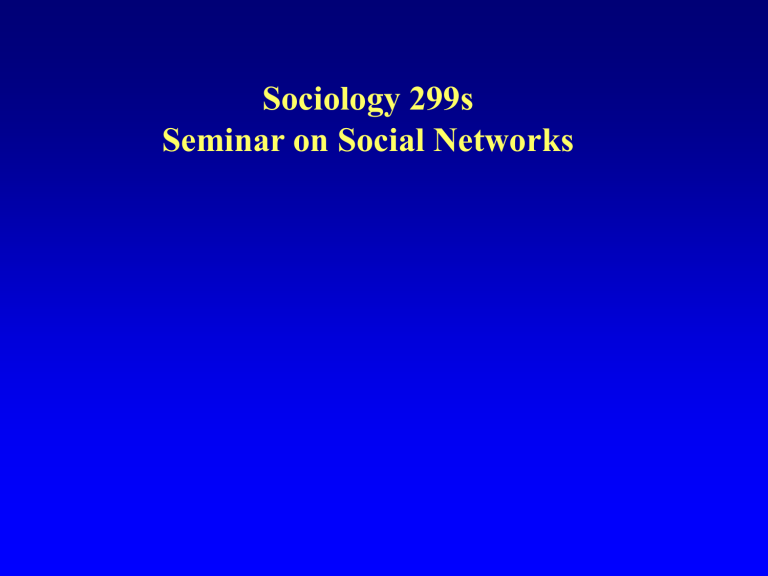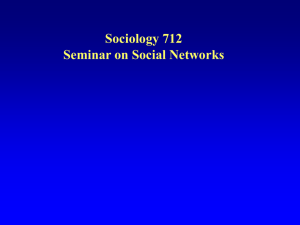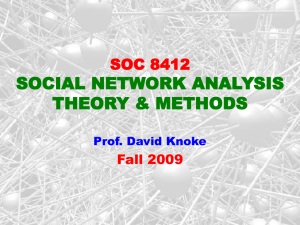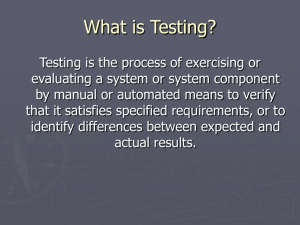Introduction to Social Network Analysis

Sociology 299s
Seminar on Social Networks
Introduction
Overview
Expectations for the course
Seminar
Homework
Final paper
Go over the Syllabus
Overview of Social Network Analysis
Theory – What makes Networks unique?
Methods – Tools & Approaches
History (Freeman)
Future/Scope (Borgatti & Butts)
Expectations
What are the expectations for the course?
1) This is a Seminar
•High level of class participation
• Critical evaluations of reading
2) Homework
•Reading -- lots of it. Read smart.
•These are methods exercises, designed to make sure you know how to do the procedures. Not complicated, and usually very short.
•Self-graded: Solutions are posted along with the problems.
3) Final Paper
•Goal is to get something interesting published.
•Paper need to use either network ideas or methods
•Can be a revision of another paper (MA, course paper, etc.)
•Can be co-authored (up to 3 authors).
Syllabus
Class Overview:
Theory: How does network Analysis differ?
We live in a connected world:
“To speak of social life is to speak of the association between people – their associating in work and in play, in love and in war, to trade or to worship, to help or to hinder. It is in the social relations men establish that their interests find expression and their desires become realized.”
Peter M. Blau
Exchange and Power in Social Life , 1964
"If we ever get to the point of charting a whole city or a whole nation, we would have … a picture of a vast solar system of intangible structures, powerfully influencing conduct, as gravitation does in space. Such an invisible structure underlies society and has its influence in determining the conduct of society as a whole."
J.L. Moreno, New York Times , April 13, 1933
These patterns of connection form a social space, that can be seen in multiple contexts:
Theory: How does network Analysis differ?
Source: Linton Freeman “See you in the funny pages”
Connections , 23, 2000, 32-42.
Theory: How does network Analysis differ?
High Schools as Networks
Theory: How does network Analysis differ?
And yet, standard social science analysis methods do not take this space into account.
“For the last thirty years, empirical social research has been dominated by the sample survey. But as usually practiced, …, the survey is a sociological meat grinder, tearing the individual from his social context and guaranteeing that nobody in the study interacts with anyone else in it.”
Allen Barton, 1968 (Quoted in Freeman 2004)
Moreover, the complexity of the relational world makes it impossible to identify social connectivity using only our intuition.
Social Network Analysis (SNA) provides a set of tools to empirically extend our theoretical intuition of the patterns that compose social structure.
Theory: Why would networks matter?
Local vision
Theory: Why would networks matter?
Global vision
Network Methods: How Different?
Social network analysis is:
•a set of relational methods for systematically understanding and identifying connections among actors. SNA
•is motivated by a structural intuition based on ties linking social actors
•is grounded in systematic empirical data
•draws heavily on graphic imagery
•relies on the use of mathematical and/or computational models.
•Social Network Analysis embodies a range of theories relating types of observable social spaces and their relation to individual and group behavior.
Network Methods: How Different?
What are social relations?
A social relation is anything that links two actors.
Examples include:
Kinship
Friendship
Co-membership
Talking with
Love
Exchange
Coauthorship
Hate
Trust
Fighting
Network Methods: What Properties do we study?
The substantive topics cross all areas of sociology. But we can identify types of questions that social network researchers ask:
1) Social network analysts often study relations as systems.
That is, what is of interest is how the pattern of relations among actors affects individual behavior or system properties.
Network Methods: What Properties do we study?
Other system examples include:
Social Cohesion
Relational (as opposed to property) notions of class
Hierarchy and Domination
Inter-group relations
Network Methods: What Properties do we study?
2) Networks as social contexts
•How does the network environment affect an actor’s behavior?
•Examples:
Peer influence on delinquency
Corporate interlocks and political participation
International trade and war
Network Methods: What Properties do we study?
3) Conduits for diffusion
•Relations are like wires or pipes: risks and resources flow through relations. This can have very wide implications:
•Diffusion of innovations (fads, rumors, etc.)
•Disease diffusion (STDs)
Network Methods: What Properties do we study?
Social Network analysis lets us answer questions about social interdependence.
These include:
“Networks as Variables” approaches
•Are kids with smoking peers more likely to smoke themselves?
•Do unpopular kids get in more trouble than popular kids?
•Do central actors control resources?
“Networks as Structures” approaches
•What generates hierarchy in social relations?
•What network patterns spread diseases most quickly?
•How do role sets evolve out of consistent relational activity?
Both: Connectionist vs. Positional features of the network
We don’t want to draw this line too sharply: emergent role positions can affect individual outcomes in a ‘variable’ way, and variable approaches constrain relational activity.
Network Methods: What Properties do we study?
Levels of Analysis
Global-Net
Ego-Net
Best Friend
Dyad
2-step
Partial network
Primary
Group
Social Network Data
Basic Data Elements: Levels of analysis
We can examine networks across multiple levels:
1) Ego-network
- Have data on a respondent (ego) and the people they are connected to
(alters). Example: 1985 GSS module
- May include estimates of connections among alters
2) Partial network
- Ego networks plus some amount of tracing to reach contacts of contacts
- Something less than full account of connections among all pairs of actors in the relevant population
- Example: CDC Contact tracing data for STDs
Social Network Data
Basic Data Elements: Levels of analysis
We can examine networks across multiple levels:
3) Complete or “Global” data
- Data on all actors within a particular (relevant) boundary
- Never exactly complete (due to missing data), but boundaries are set
-Example: Coauthorship data among all writers in the social sciences, friendships among all students in a classroom
Network Methods: What
Properties do we study?
Global Networks
Net as Independent
Net as Dependent
Local Networks
Network Methods: How do data differ?
The unit of interest in a network are the combined sets of actors and their relations.
We represent actors with points and relations with lines.
Actors are referred to variously as:
Nodes, vertices, actors or points
Relations are referred to variously as:
Edges, Arcs, Lines, Ties
Example: b d a c e
Network Methods: How do data differ?
Social Network data consists of two linked classes of data: a) Nodes: Information on the individuals (actors, nodes, points, vertices)
• Network nodes are most often people, but can be any other unit capable of being linked to another (schools, countries, organizations, personalities, etc.)
• The information about nodes is what we usually collect in standard social science research: demographics, attitudes, behaviors, etc.
•
Often includes dynamic information about when the node is active
Graph theory notation: G(V,E)
Network Methods: How do data differ?
Social Network data consists of two linked classes of data: b) Edges : Information on the relations among individuals (lines, edges, arcs)
• Records a connection between the nodes in the network
•
Can be valued, directed (arcs), binary or undirected (edges)
• One-mode (direct ties between actors) or two-mode (actors share membership in an organization)
•
Includes the times when the relation is active
Graph theory notation: G(V,E)
Network Methods: How do data differ?
In general, a relation can be: (1) Binary or Valued (2) Directed or Undirected a b d c
Undirected, binary e a
1 b d
3 1 c 4
Undirected, Valued
2 e a a b c
Directed, binary d b c
Directed, Valued d e e
The social process of interest will often determine what form your data take. Almost all of the techniques and measures we describe can be generalized across data format.
Network Methods: How do data differ?
In general, a relation can be: (1) Binary or Valued (2) Directed or Undirected b d a c e
Directed,
Multiplex categorical edges
The social process of interest will often determine what form your data take. Conceptually, almost all of the techniques and measures we describe can be generalized across data format, but you may have to do some of the coding work yourself….
History: Trends
Fast growing, dynamic field.
Interdisciplinary:
Freeman (fig 1.1) shows that the
Networks are showing up in many more substantive areas each year
Where does SNA fit in the overall scheme of Social Science?
Articles with “social network” in title or abstract in Sociological Abstracts.
Borgatti & Foster JoM 2003 29:991-1013
History: Trends
Where does SNA fit in the overall scheme of Social Science?
Fast growing, dynamic field.
Interdisciplinary:
Freeman (fig 1.1) shows that the
Networks are showing up in many more substantive areas each year
"Social Networks" in Web of Science
Social Science Citation Index (1958 - 2008)
450
400
350
300
250
200
150
100
50
0
1950 1960 1970 1980 1990 2000 2010 2020
Year
Find much the same trend if you look at Web of Science instead…
History: Intellectual Development
The Development of Social Network Analysis by Linton Freeman
•Prehistory
•
Theory : Comte, Spenser, Durkheim, and most importantly Simmel
•
Data : A number of early anthropologists (1800s) and developmental psychologists (1920s).
•
Graphic Imagery : Very early in describing descent systems & kinship. Hobson (1894) showed overlapping directors
•Mathematics & Computation: Probability and formal algebra on relational data (1870s)
All of these were ‘fits and starts’ that did not lead to anything systematic
History: Intellectual Development (“prehistory”)
Euler, 1741
Euler’s treatment of the “Seven Bridges of Kronigsberg” problem is one of the first moments of graph theory….
History: Intellectual Development (“prehistory”)
The study of network has depended on a graphical element since its first moments:
Or early representations of organizational relations (1921)
History: Intellectual Development (“prehistory”)
The study of network has depended on a graphical element since its first moments:
..but Moreno’s sociograms from Who Shall Survive (1934) are typically seen as the beginnings of social network analysis (certainly if you were to ask
Moreno!).
History: Intellectual Development (“prehistory”)
Lundberg & Steel 1938 – Using a “Social Atom” representation
The flow of images continued over time, marking a wide range of potential styles….
History: Intellectual Development (“prehistory”)
Charles Loomis – 1948
Loomis, 1940s
The flow of images continued over time, marking a wide range of potential styles….
History: Intellectual Development (“prehistory”)
Northaway’s – “Target Sociograms”
Bronfenbrenner, 1941
Northway 1952
The flow of images continued over time, marking a wide range of potential styles….
History: Intellectual Development
The Development of Social Network Analysis by Linton Freeman
•Birth I: Sociometry (1930s)
-Jacob Moreno is credited with the first systematic use of SNA-like techniques, though evidence suggests he was aided strongly by Jennings.
The mathematical/probability treatment came from Lazersfeld (1938).
-The thrust died out. Freeman attributes this largely to Moreno’s idiosyncratic personality.
•Birth II: First Harvard Thrust
-Grounded in the community structure literature of Warner and Lunt.
-Bank wiring room data
-Southern Women data
-Homans’ work on interaction leading to The Human Group
-William Foote Whyte Street Corner Society
With one exception, most of this work failed to do the math needed to make it really SNA. More importantly, it didn’t provide a general frame for others to work within. The actors also moved apart, making progress difficult.
History: Intellectual Development
The Development of Social Network Analysis by Linton Freeman
•Dark Ages I: 1940s
-Bavelas, Festinger, Harary, Cartwright, Heider, Katz, all made strong contributions.
-The work was fundamental, but did not take off to other substantive areas.
•Dark Ages II: 1950s
-Work in Lund , Sweden, looking at innovation diffusion
-Work in Chicago
, including Rapoport’s famous studies, the work was killed by the Communist scare in the 50s
Columbia had Merton and Lazarsfeld, who developed centers doing network research, providing a model but not a strong start
-Everett M. Rogers (from Iowa, through OSU, to Michigan
State) started his work.
-Radcliff-Brown identified the importance of algebreic models for any social science (see quote on p.103)
-Freeman, Fararo, Sunshine worked from Northwestern and Syracuse to make progress.
History: Intellectual Development
The Development of Social Network Analysis by Linton Freeman
•Dark Ages III: 1960s
-Ed Laumann, Peter Blau, James Davis, all started work at this time.
-“each succeeding contribution introduced a new segment of the social science community to the structural perspective. But, at the end of the 1960s, no version of network analysis was yet universally recognized as providing a general paradigm for social research. By then, however, the broad community of people engaged in social research were ready to embrace a structural paradigm.” (p.120)
History: Intellectual Development
The Development of Social Network Analysis by Linton Freeman
•Harvard Renaissance
- The key idea here is that things took off under Harrison White at Harvard.
History: Intellectual Development
The Development of Social Network Analysis by Linton Freeman
•Power of Organizations
•In the end, Freeman attributes the success of SNA to both technical changes (UCINET, in particular) and organizational changes, particularly a series of conferences that culminated in the formation of INSNA and the Sunbelt Social Network Conference.
History: Current Challenges
•Social Networks or Networks? (Borgatti Science )
•Universal or Particular?
•Static or (which) dynamic? (Butts Science )




